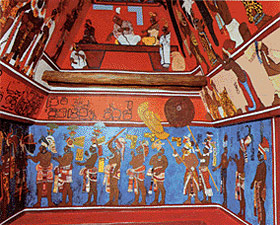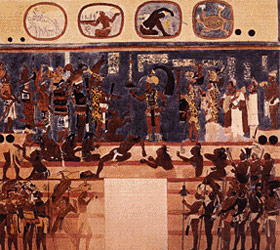 |
 |
 |
 Travel & Outdoors | April 2005 Travel & Outdoors | April 2005  
Bonampak: The Sistine Chapel of the Americas
 Jim Budd - The Herald Mexico Jim Budd - The Herald Mexico


| | The murals were painted across the ceilings and walls of three rooms in a temple at the site. Room 1 depicts scenes of dance and pageantry. Above, the Bonampak royal family watches a series of celebrations while the heir to the throne is presented to the audience. The accompanying hieroglyphic text records the date of the heir presentation on December 14, 790 AD. |
From Palenque, bus tours now run down to Bonampak, combining what to me are the two most fascinating Maya sites not only in Chiapas but in all of Mexico. Last time I was in the area, the only way to reach Bonampak was by air taxi, and I was cautioned not to try it. Now a paved highway a few kilometers from the Guatemala border passes by the road leading to the archaeological zone. You can hike, bike or board a taxi to cover the final eight kilometers.

Bonampak, with its brilliant frescoes, has been called the Sistine Chapel of the Americas. It was unknown to all but a few Lacandons until half-a-century ago, but once discovered, the world learned that the Maya previously idealized as artists, astronomers and philosophers were as warlike and cruel as the rest of the human race.

The frescos, covering the interiors of three rooms within one small temple, depict preparations for war, battle, and the victory celebration with bleeding prisoners awaiting their fate.

Painted 1,200 years ago, these murals placed Maya culture in an entirely new light. Replicas are on view at the National Museum of Anthropology, but a visit to the actual site is far more rewarding. Rewarding, yet disconcerting at first.

The few small temples are just that, small, as are the pyramids on which they stand. Bonampak is not Palenque. It is easy to understand how it remained hidden for so long.

Almost as amazing is the way the hiding place was revealed.


| | Room 2 depicts a battle that took place on August 6, 792 AD, and the presentation of captives presided over by a ruler of Bonampak. Positioned along the steps of a temple, the captives peer down at their hands in despair. |
Versions vary, but generally involve one Charles Herman Frey, a young man born in Chicago. The most appealing tale depicts him as a pacifist who found sanctuary in the Lacandon jungles of Chiapas and thus avoided serving as a soldier during the Second World War.

Frey made several trips to Mexico, lured here after working at the 1933 Chicago Exposition where he was captivated by the replica of a Maya temple built by Frans Blom.

Blom, as you may know, was a Danish scholar and photographer living in San Cristobal de las Casas in the state of Chiapas. Blom introduced Frey to the Lacandons and no doubt regretted it. Blom, one hears, always was bitter that it was Frey, not he, who discovered Bonampak.

Frey, in his 20s, was a precursor of the hippies and backpackers who would arrive in subsequent decades. Wandering through Yucatan and Quintana Roo, often without a peso to his name, he eventually settled among the Lacandons in a village and wed a Lacandon woman. He gave up calling himself Herman. Now he was Carlos.

The Lacandons are one of those groups never conquered by the Spaniards and never converted to Christianity. They worshiped the old gods in the old way at the old temples. One of these temples was Bonampak. Frey would have been sworn to keep the location secret. He broke that promise.

Once the war ended, no doubt hoping his own avoidance of conscription would be forgotten if he became a media hero, Frey, according to one account, contacted Life magazine and persuaded the editors to send in a writer and photographer. Frey would lead them to the site. As related to by my guide, on their return voyage along the Usumacinta River, Frey's canoe capsized and he was drowned. The Maya gods had taken their revenge.

Actually, Frey lived for three more years, although he did drown in the Usumacinta during 1949. It may be that those gods merely decided to torment him first. Another U.S. citizen, Giles Healey backed by the United Fruit Company had taken credit for first revealing Bonampak to the world and Frey spent his final months fighting for the recognition he believed he deserved.

Posthumously, Frey won that recognition. A bust of him stands in a small park in Tuxtla Gutièrrez and one son lives there, or at least did live there 10 years ago.

Getting to Bonampak is still an adventure and guided tours are the best way to go. Trouble is, the trip takes a full day, most of it spent traveling. Visitors are hustled in to see the murals and then hustled out. Many go on to take a boat trip along the Usumacinta to see more ruins at Yaxchilan. No murals there, but it is still exciting, like being Laura Croft and raiding a tomb.

jimmbudd1@aol.com | 
 | |
 |



